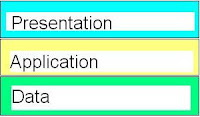Business Analysis, Automation, Offshoring and Jobs
One aspect of traditional business analysis was to look at how tasks within an organisation could be made more efficient. Initially this meant looking at how database systems and software applications could be created to support people in organisations with the intention of lifting the productivity of these people. One effect of this (if done successfully) is that businesses need to employ less people to do the same amount of work. With the emergence of the internet it is now apparent that a large number of organisations have participated, or are participating in, a new wave of automation that significantly affects jobs. This is particularly obvious in the retail sector, where the low overheads of having an online business allow prices that challenge many brick-and-mortar retailers (See for example: Harvey's war on Cheap TVs, Harvey Norman Reveals Online Move and Second Wave of Closures Hits Angus-Robertson). Of course, there is another element to this: offshoring. While business analysis may involve looking at which processes can be offshored, Ford (2009) takes this further by linking the offshoring of jobs with the automation of jobs and suggests that in many cases this is an either-or choice.
Ford (2009) discusses how "knowledge economy jobs" are the ones that are most ripe for automation (counter-intuitively as they are supposed to be high skill jobs), however, a common precursor to automation of these jobs is that they are offshored to countries with lower wages. This again impacts local employment as these jobs are lost. See, for example, Online Shopping Threatens Local Jobs and also Foxconn Robots. Of course, one may argue that retail jobs are not really knowledge economy jobs. This is true and I will present Ford (2009)'s arguments that knowledge jobs are subject to the same offshoring/automation pressures in more detail shortly. Before that, lets just quickly consider the effects of either automation or offshoring. One effect is that the price of goods and services goes down as costs are reduced. This is the claimed economic positive. However, another effect is that some people may be now unemployed or underemployed (at least temporarily). This effect is more dubious, as in theory the reduction in income is offset by cheaper goods and services and now - the big leap of faith - the loss of jobs in one area allows people to be re-deployed in other areas of the local economy. Why wouldn't this happen? Rather than entering into an in-depth analysis of this, let me just suggest that it doesn't always work very well, with the American Rust Belt perhaps being one example (the last two paragraphs of this article are interesting in this regard). In such cases, mass relocations of people may be necessary leading to other, hidden, costs such as loss of amenity from prior infrastructure investments etc. Ford (2009) argues that there is also a psychological effect at play here. As people see jobs dissappearing due to offshoring and/or automation, they reduce spending. This drop in demand for good and services may in itself be sufficient to lead to further job loses.
Now let us examine Ford (2009)'s case that knowledge workers' jobs are at risk from automation. The basic premise on which he builds his argument is that people underestimate what can be done with software and hardware. Jobs, or aspects of jobs, that appear to require high levels of knowledge and skill can be automated sufficiently well to replace humans, even if the quality of outcomes is not quite as high in some cases (although it may well be higher). The second aspect of his argument is that knowledge workers are often highly educated and highly paid. Their high pay is what makes it worth trying to automate (or offshore) as the savings are considerably more than for a lower paid job. Even if only some aspects of a knowledge job are automated you can potentially reduce the workforce considerably. However, Ford imagines a far bleaker scene: wholesale automation of jobs across the board, well beyond the capacity for any 'new' jobs that might be created to absorb the losses. He imagines a world where the rich get richer while the poor get poorer - until the economy stalls entirely at which point all wealth declines as demand for goods and services crashes (this is somewhat consistent with Wealth Trickling Up Not Down). Ford thinks this in fact was a contributing factor to the 2008 Global Financial Crisis (GFC).
There are a number of the reasons why Ford thinks that automation will be so successful. While offshoring reduces costs eventually companies will look to automation . This will allow them to compete with cheap labour AND produce the high quality, precision products that people expect. The other thing is that products themselves are being designed so as to support automation. Even a job such as motor mechanic which requires human skills such as visual recognition and physical manipulation he sees as threatened. Already cars can be repaired based on computerised diagnostic tools and it seems feasible that they may be designed in such a manner as to simplify automation for robotics. However, there are many more vulnerable jobs which require less human skill (see for example Food Inc). Supermarket shelf stocking is one with an appropriately designed physical layout. As another example we are all now familiar with the self-serve automated checkouts at our local supermarkets. In fact, Ford picks up on this very type of activity: in the service sector automation pushes the difficult parts of the job onto the customer. Another group he sees at immediate risk are those with what he calls "interface" jobs. These are people who essentially collect together documents and enter them into systems or send them to other systems. As more businesses provide documents online (eg: bank statements) these types of exchange between systems will be easier to automate.
Ford is not the only one who has spotted this trend towards eliminating highly paid, highly educated specialised workers. Schmidt (2000) also points out that highly trained workers are expensive which drives employers to try and reduce the discretion of professionals by either standardising the work procedure or introducing "'expert' computer systems" (pg 38) the intention of which is to "transform the employee's decision making into a routine or rote activity and tend to strip the work-result of any imprint of the employee's own thinking" (pg 36).
Ford continues in his book to identify a number of social dangers that may arise from increasing automation and wealth inequality. This raises some very interesting questions, most of which I will leave for discussion at another time. However, one of interest is the predicament of China. China has developed as the "world's factory" due to its low-cost low-paid labour force. These people expect at some stage to reap the benefits of their industrialisation by achieving higher standards of living. However, Ford fears that any attempt to improve the conditions or pay of Chinese workers will lead to automation of China's factories and mass-unemployment in China (see the Foxconn article again). He also accuses automation and off-shoring of contributing to the GFC, but more on this later.
References
Ford, M. 2009. The Lights in the Tunnel, Acculant.
Schmidt, J. 2000. Disciplined Minds: A Critical Look at Salaried Professionals and the Soul-Battering System that Shapes their Lives, Rowman and Littlefield.
Labels: automation, Business Analysis














